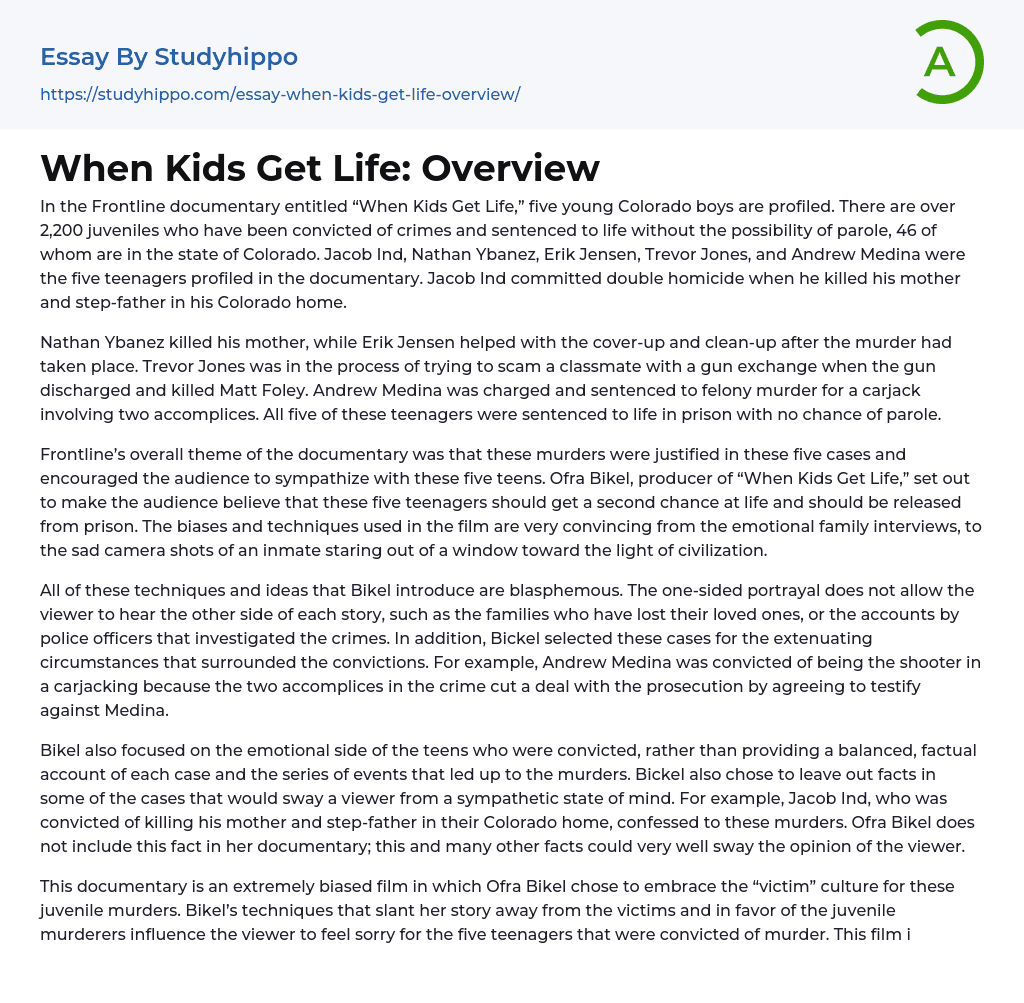In the Frontline documentary entitled “When Kids Get Life,” five young Colorado boys are profiled. There are over 2,200 juveniles who have been convicted of crimes and sentenced to life without the possibility of parole, 46 of whom are in the state of Colorado. Jacob Ind, Nathan Ybanez, Erik Jensen, Trevor Jones, and Andrew Medina were the five teenagers profiled in the documentary. Jacob Ind committed double homicide when he killed his mother and step-father in his Colorado home.
Nathan Ybanez killed his mother, while Erik Jensen helped with the cover-up and clean-up after the murder had taken place. Trevor Jones was in the process of trying to scam a classmate with a gun exchange when the gun discharged and killed Matt Foley. Andrew Medina was charged and sentenced to felony murder for a carjack
...involving two accomplices. All five of these teenagers were sentenced to life in prison with no chance of parole.
Frontline’s overall theme of the documentary was that these murders were justified in these five cases and encouraged the audience to sympathize with these five teens. Ofra Bikel, producer of “When Kids Get Life,” set out to make the audience believe that these five teenagers should get a second chance at life and should be released from prison. The biases and techniques used in the film are very convincing from the emotional family interviews, to the sad camera shots of an inmate staring out of a window toward the light of civilization.
All of these techniques and ideas that Bikel introduce are blasphemous. The one-sided portrayal does not allow the viewer to hear the other side
of each story, such as the families who have lost their loved ones, or the accounts by police officers that investigated the crimes. In addition, Bickel selected these cases for the extenuating circumstances that surrounded the convictions. For example, Andrew Medina was convicted of being the shooter in a carjacking because the two accomplices in the crime cut a deal with the prosecution by agreeing to testify against Medina.
Bikel also focused on the emotional side of the teens who were convicted, rather than providing a balanced, factual account of each case and the series of events that led up to the murders. Bickel also chose to leave out facts in some of the cases that would sway a viewer from a sympathetic state of mind. For example, Jacob Ind, who was convicted of killing his mother and step-father in their Colorado home, confessed to these murders. Ofra Bikel does not include this fact in her documentary; this and many other facts could very well sway the opinion of the viewer.
This documentary is an extremely biased film in which Ofra Bikel chose to embrace the “victim” culture for these juvenile murders. Bikel’s techniques that slant her story away from the victims and in favor of the juvenile murderers influence the viewer to feel sorry for the five teenagers that were convicted of murder. This film is not “the truth” but rather “the truth in Ofra’s eyes”. “When Kids Get Life” is a derogatory, biased, slanted, yet enticing film that was developed to sway the opinion of the viewer toward a sympathetic state of mind for five teenagers that took the lives of
other human beings.
- Family essays
- Wealth essays
- Punctuality essays
- Carpe diem essays
- Persistence essays
- Chicken essays
- Crops essays
- Object essays
- Adaptation essays
- Love Story essays
- Mystery essays
- Thank You essays
- Hero essays
- Farm essays
- Focus essays
- Development essays
- Welding essays
- Nursing essays
- Integrity essays
- Hypocrisy essays
- Mother Tongue essays
- Contrast essays
- Secret essays
- First Love essays
- Motherhood essays
- Beauty essays
- Alcohol essays
- Aging essays
- Narcissism essays
- Myself essays
- Greed essays
- Limitations essays
- Fire essays
- House essays
- Peel essays
- Evil essays
- Humility essays
- Perspective essays
- Dream essays
- Change essays
- Choices essays
- Toys essays
- Experience essays
- Wisdom essays
- Transport essays
- Barbie Doll essays
- Adversity essays
- Lifestyle essays
- Housing essays
- Holiday essays




